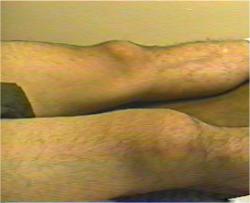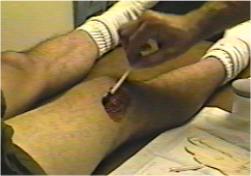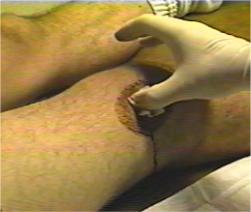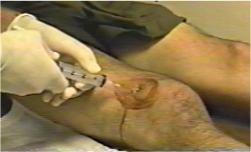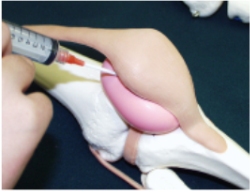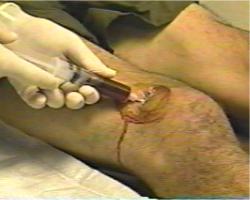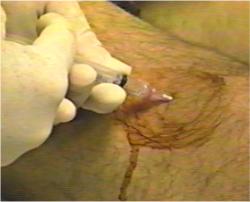|
|
|||||
Tap a KneeAfter a traumatic injury, blood may collect in the sac behind the knee cap, causing swelling, pain, and immobility. This collection of blood should be removed. Prepare the skin with an antiseptic solution. Feel the knee cap (patella). The point of insertion of the needle will be just underneath the knee cap at the top (anterior) lateral (to the side) margin. Inject a small amount of local anesthetic at the injection site, or place a topical anesthetic agent in that area. Use a large bore needle (like an 18 gauge) attached to a syringe. Insert the needle, directing the tip to a point just below the center of the knee cap. You will feel a "pop" as you enter the sac. Aspirate as much blood as you can. If you fill one syringe, grasp the needle hub with a hemostat, untwist the syringe, empty it, re-attach it to the needle, and aspirate more. 40-50 cc of blood is not unusual. As the blood is aspirated, the patient will feel some relief. When no more blood can be aspirated, grasp the needle hub with a hemostat (for stability) and unscrew the syringe. Replace it with a 5cc syringe filled with 1% lidocaine. Inject the lidocaine back into the sac. It should flow easily. The lidocaine will relieve pain, and make the later examination much more comfortable. Move the knee (flexing and extending) to distribute the lidocaine evenly throughout the sac. Watch a video demonstrating this technique.
Contributed by Scott D. Flinn, MD
Home · Military Medicine · Sick Call · Basic Exams · Medical Procedures · Lab and X-ray · The Pharmacy · The Library · Equipment · Patient Transport · Medical Force Protection · Operational Safety · Operational Settings · Special Operations · Humanitarian Missions · Instructions/Orders · Other Agencies · Video Gallery · Forms · Web Links · Acknowledgements · Help · Feedback Approved for public release; Distribution is unlimited.
*This web version is provided by The Brookside Associates, LLC. It contains original contents from the official US Navy NAVMED P-5139, but has been reformatted for web access and includes advertising and links that were not present in the original version. The medical information presented was reviewed and felt to be accurate in 2001. Medical knowledge and practice methods may have changed since that time. Some links may no longer be active. This web version has not been approved by the Department of the Navy or the Department of Defense. The presence of any advertising on these pages does not constitute an endorsement of that product or service by either the US Department of Defense or the Brookside Associates. The Brookside Associates is a private organization, not affiliated with the United States Department of Defense.
© 2015, Brookside Associates, LLC. All rights reserved |
|
||||

